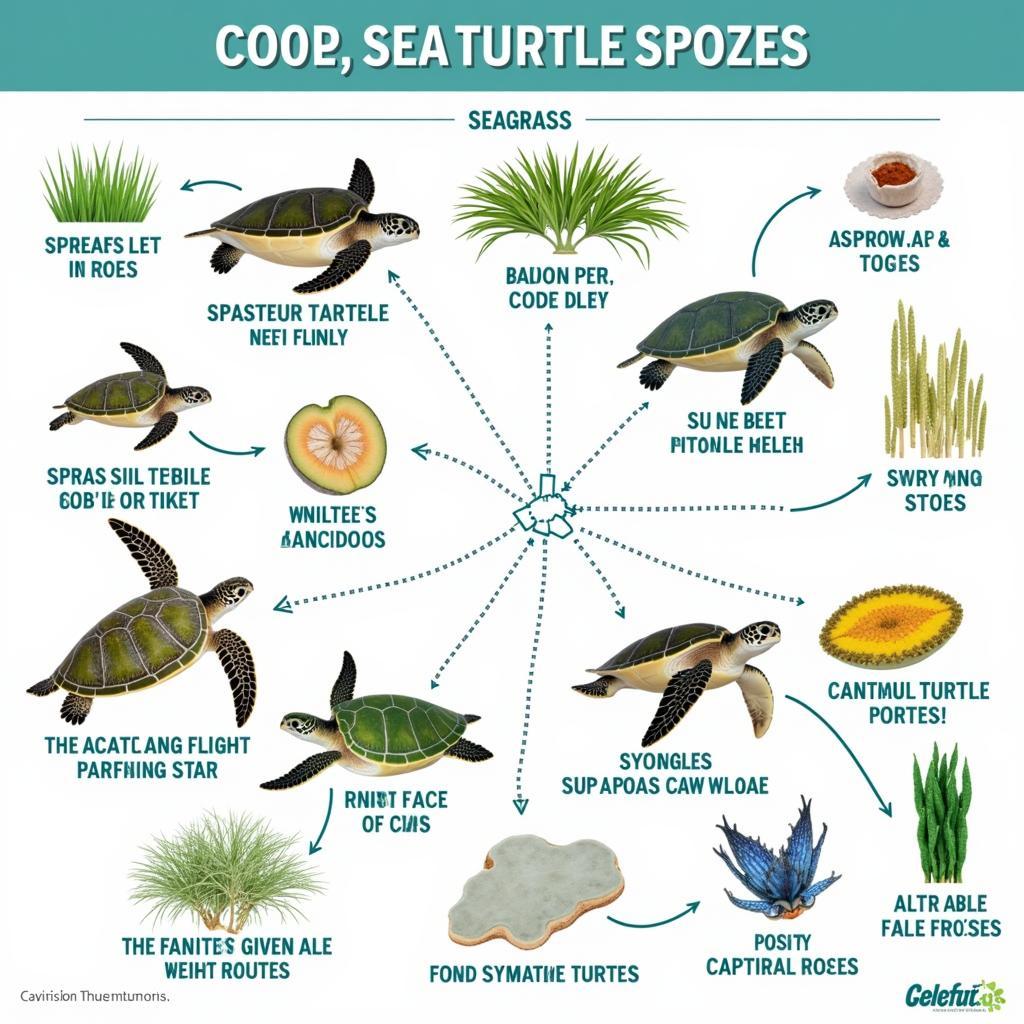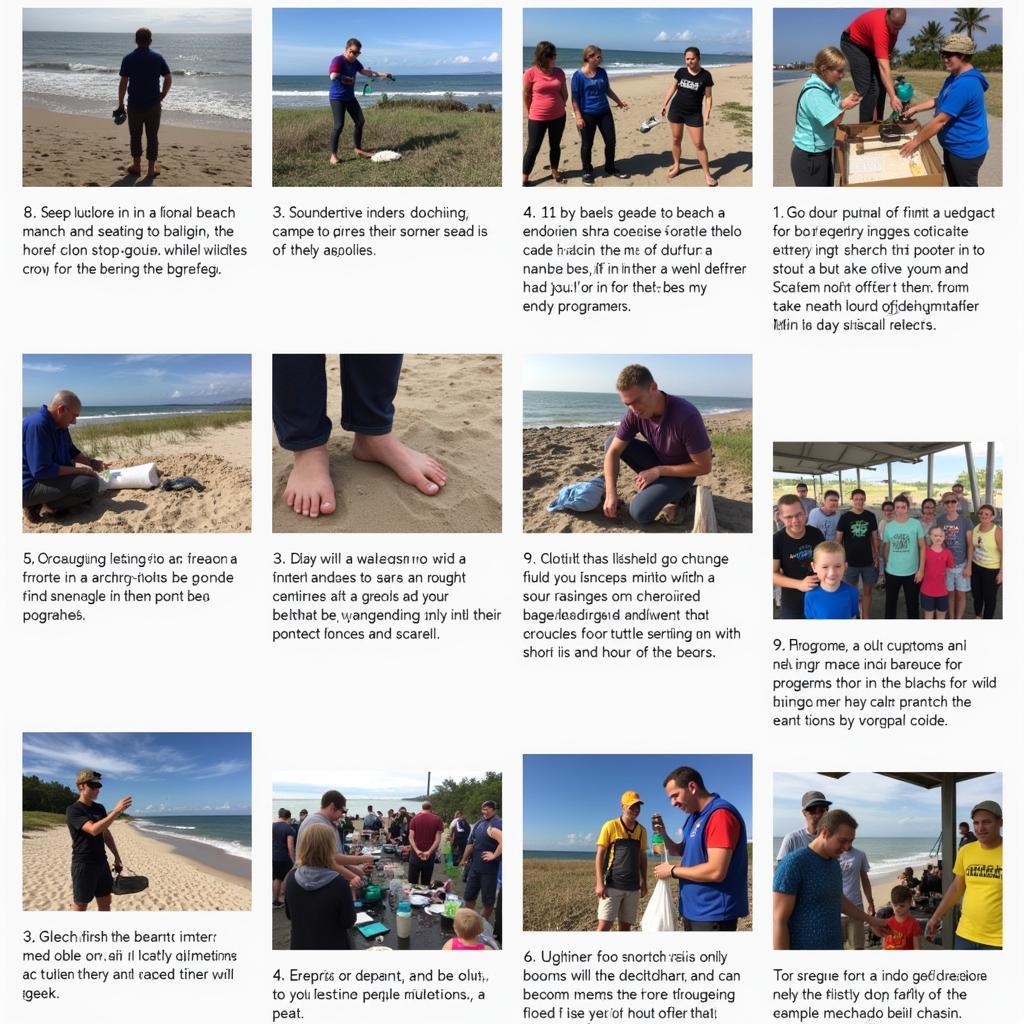The Food Chain Of A Sea Turtle plays a vital role in maintaining the health of ocean ecosystems. From hatchlings to adults, these ancient mariners have distinct diets shaped by their size, species, and habitat. Understanding their place in the food web is crucial for conservation efforts.
Understanding the food chain of sea turtles is essential to protecting these magnificent creatures. What do they eat, and what eats them? Let’s delve into the fascinating world of sea turtle diets and their intricate connections within the marine ecosystem. Check out our article on the food chain of sea turtles for a deeper dive.
What Do Sea Turtles Eat? A Journey Through Their Diet
Sea turtles exhibit a fascinating range of dietary preferences, depending on their species and life stage. Some species are primarily carnivorous, while others are herbivorous, and some even switch between the two throughout their lives.
-
Green Sea Turtles: As adults, green sea turtles primarily graze on seagrass and algae, earning them their name due to the greenish hue their fat takes on from their plant-based diet. Younger green turtles, however, are more omnivorous, consuming invertebrates like jellyfish and crabs.
-
Loggerhead Sea Turtles: Loggerheads are mainly carnivorous, using their powerful jaws to crush hard-shelled prey like conchs and crabs. They also consume fish and jellyfish.
-
Hawksbill Sea Turtles: Hawksbills specialize in eating sponges, which are a significant part of coral reef ecosystems. Their beak-like mouths are perfectly adapted for reaching into crevices and extracting these invertebrates.
-
Leatherback Sea Turtles: The largest of all sea turtles, leatherbacks feed almost exclusively on jellyfish, playing a vital role in controlling jellyfish populations. Their throats are lined with spiny projections to help them swallow these gelatinous creatures.
-
Olive Ridley Sea Turtles: These turtles have a varied diet consisting of jellyfish, snails, crabs, shrimp, and occasionally algae and fish. Their adaptability allows them to thrive in various habitats.
 Sea Turtle Diet Variations Across Species
Sea Turtle Diet Variations Across Species
Predators and Threats: The Dangers Sea Turtles Face
While adult sea turtles are relatively safe due to their size and shell, they still face threats from large sharks, orcas, and saltwater crocodiles. Hatchlings, however, are extremely vulnerable. As they make their perilous journey from nest to sea, they become prey for a variety of predators, including birds, crabs, foxes, and raccoons. Once in the water, they are also vulnerable to fish and other marine animals.
Human Impact on the Food Chain of Sea Turtles
Sadly, human activities significantly impact sea turtle populations and their food chain. Plastic pollution is a major threat, as turtles often mistake plastic bags for jellyfish, leading to ingestion and blockage of their digestive systems. Fishing nets also pose a severe danger, entangling turtles and causing drowning. Coastal development destroys nesting habitats, further jeopardizing their survival. Explore further about the sea turtle food web at food web sea turtle.
“Loss of seagrass beds due to pollution and coastal development has a devastating impact on green sea turtle populations, disrupting the delicate balance of the marine ecosystem,” explains Dr. Amelia Hernandez, a marine biologist specializing in sea turtle conservation.
 Sea Turtle Hatchling Predators on Land and Sea
Sea Turtle Hatchling Predators on Land and Sea
Protecting Sea Turtles: Conservation Efforts
Numerous organizations are dedicated to protecting sea turtles and their habitats. These efforts include:
- Beach cleanups to remove plastic and other debris.
- Turtle nest monitoring and protection programs.
- Promoting sustainable fishing practices to reduce bycatch.
- Educating the public about the importance of sea turtle conservation.
- Supporting research to better understand sea turtle biology and behavior.
“Supporting organizations dedicated to sea turtle conservation is crucial for ensuring the survival of these incredible animals and the health of our oceans,” states Dr. James Riley, a leading expert in marine conservation. For some fun food ideas, check out our teenage mutant ninja turtles party food ideas.
 Various Sea Turtle Conservation Efforts
Various Sea Turtle Conservation Efforts
In conclusion, understanding the food chain of a sea turtle is crucial for protecting these endangered species. By addressing the threats they face and supporting conservation efforts, we can help ensure that these magnificent creatures continue to grace our oceans for generations to come.
FAQ
- What is the main food source for green sea turtles? Seagrass and algae.
- What are the biggest threats to sea turtle hatchlings? Predators like birds, crabs, and fish, as well as human activities.
- How does plastic pollution affect sea turtles? They often mistake plastic bags for jellyfish and ingest them, leading to digestive problems.
- What are some ways to help protect sea turtles? Participating in beach cleanups, supporting conservation organizations, and making sustainable choices.
- Why are sea turtles important for the ocean ecosystem? They play a vital role in maintaining the health of seagrass beds and controlling jellyfish populations.
- What do loggerhead sea turtles eat? Primarily hard-shelled prey like conchs and crabs.
- What is the unique adaptation of the hawksbill sea turtle’s beak? It’s adapted for extracting sponges from coral reefs.
For support, please contact us at Phone Number: 02437655121, Email: minacones@gmail.com Or visit us at: 3PGH+8R9, ĐT70A, thôn Trung, Bắc Từ Liêm, Hà Nội, Việt Nam. We have a 24/7 customer support team.